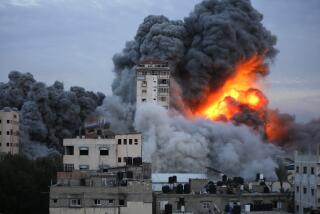Weapons in Gulf War
- Share via
Re “Military Pitchmen Took U.S. for Ride on ‘Smart’ Weapons,” editorial, July 10:
The term “smart” bombs was incorrectly used to describe those weapons used in the Gulf War; the proper term would be “precision guided bombs.” The weapons had “eyes” but did not have “brains.” Images were then transmitted to a human pilot or controller, who then used his brains to attempt to guide the weapon to the target.
A true smart bomb would have both eyes and brains contained in the weapon itself. Sensors (eyes) would form images of the target area, while a miniature computer (brains also contained within the weapon) would perform automatic target recognition and thereby guide the weapon to the target.
Because of the possibilities of degradation by rain, clouds, fog, smoke and humidity, the images formed by the sensors become much more reliable as the weapon approaches the target. Further, there would be no degradation by having to transmit images and commands to and from the controller under such adverse conditions.
It is absolutely foolish to risk the billions and billions spent on stealth fighters and bombers to risk the lives of pilots having to fly over dangerous territory, in order to deliver a weapon less accurately than a smart bomb could do from standoff launch positions of ground or air.
MARVIN STERN
Santa Ynez
* In your eagerness to condemn “military pitchmen” and the Pentagon, you draw many inferences from a classified GAO report from which you say you’ve seen only a “brief unclassified summary.” You offer not a single statistic to support your hasty conclusion that the F-117 stealth fighter may represent “too many bucks for the bang.”
Here are some statistics made available to Times reporters by the Air Force and the contractor many times since Desert Storm, but never printed: In that operation, F-117s of the 37th Tactical Fighter Wing flew more than 1,270 sorties (individual combat flights) involving 6,900 hours of combat-zone flying; not one F-117 was hit by enemy fire and not one pilot injured. Thanks to the then new radar-evading stealth technology, this represented a remarkable first in the history of air warfare.
JAMES W. RAGSDALE
West Hollywood
More to Read
Sign up for Essential California
The most important California stories and recommendations in your inbox every morning.
You may occasionally receive promotional content from the Los Angeles Times.













